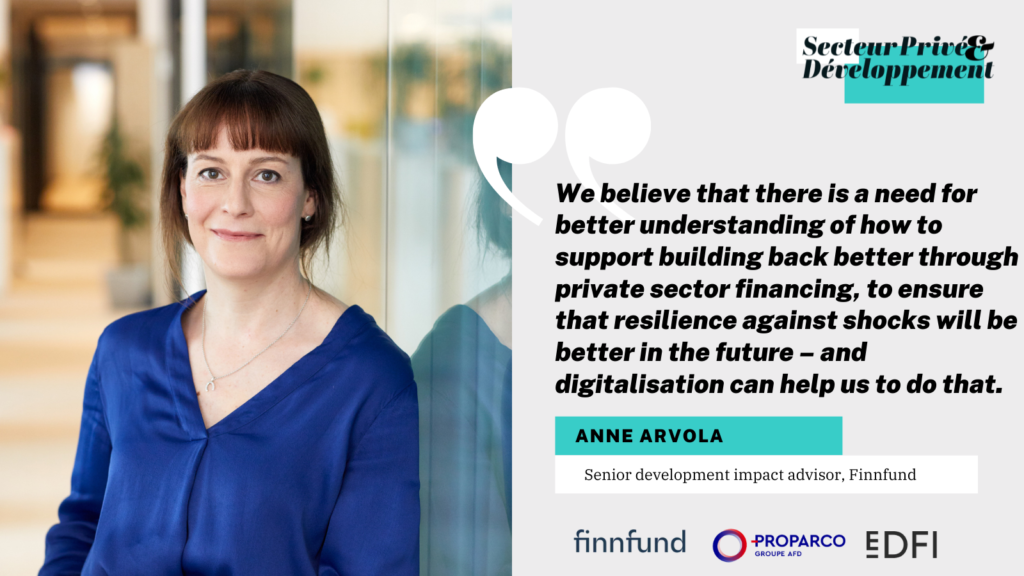June 6, 2022
Stakeholders’ voice – using technology to collect feedback directly from the key people
The world has now lived with the Covid-19 pandemic for over two years. The evidence shows that it has hit the least-developed countries the hardest. At the same time, climate change is increasingly affecting peoples’ daily lives. Again, those already in vulnerable positions are suffering the most. In this milieu, there is a need to understand the roles and impacts of companies, and the development financiers and investors backing them, on peoples’ lives. New digital tools are making this possible.
In the absence of comprehensive social security systems and government budgets to invest in climate adaptation and resilience, expectations for the private sector to fill the gap are high – and even higher during a health crisis. There is also a need for better understanding of the role of development financiers and other investors in the picture and support for ‘building back better’ to ensure resilience against shocks will be better in the future. In order to analyse the impacts companies can have on peoples’ lives, we need to ask their key stakeholders directly about these. New digital tools can help us to deal with the challenges caused by travel restrictions and other limitations in collecting data from stakeholders.
In collaboration with WorkAhead, a Finnish tech company, Finnfund has been developing in 2020-2021 a practical survey tool that allows companies to reach out to their stakeholders, such as employees, communities, and suppliers. The aim is to build understanding of the wider impacts that companies have on their stakeholders’ lives. In addition, these surveys can strengthen relationships with important stakeholders, such as workers, neighbouring communities, partners, and suppliers.
Monitoring reports, visits and specific audits can only confirm compliance with policies and practices and provide impact data collected at the ‘output level’. For example, ‘number of jobs and suppliers’ does not tell us how the more secure income from a quality job or an established supplier relationship can change lives more broadly.
Traditionally, these wider impacts have been explored through specific studies and data collection methods that often involve time-consuming in-person and group interviews, making the exercises expensive and not easy to repeat on a regular basis. Even though such studies are critical in building an in-depth understanding of impact mechanisms, they do not work well for regular monitoring.
During the two piloting phases, we worked towards a standardized set of questions that would allow us to gradually build time series for companies to compare their own performance over the years. Data accumulating from portfolio companies will allow them to compare their performance with their peers, and the poverty probability index data allows comparisons at the national level. As we begun the first pilots in 2020, some of the companies were slightly reserved on the method, but after completing the pilot, they were keen to continue using the tool.

Reaching large groups of people even during the pandemic
The guiding principle in developing the tool was that it should be scalable and cost-effective, allowing easy data collection from large groups of respondents. The surveying application presents the respondents with a user interface enabling them to hear questions in their own language, and with a video. They may then answer multiple-choice questions by selecting given symbols. The technology allows those who cannot read or write to participate.
Facilitators conducting the surveys in the field hand respondents a smartphone with the app, guide them in getting started, and then provide them with a safe and private space to ensure anonymity in giving their responses. Responses are uploaded when an internet connection is available. Thus, surveys can be conducted where there is no connectivity. Depending on the number of smartphones available and other practicalities in assembling people for surveying – such as pandemic-related restrictions and safety measures – one facilitator could survey hundreds of respondents in a day. Even though gathering people together may be challenging, the survey allows collecting peoples’ views during times of travel and meeting restrictions: facilitators can be easily trained with basic skills in carrying out the survey; thus, local teams – for example, HR teams and corporate social officers – can collect the data.
The pandemic may have influenced peoples’ lives in many ways: family members may have fallen ill, and lockdowns may have cut incomes and even destroyed livelihoods. Children might have dropped out of school if there were no opportunities for distance learning. Furthermore, they may have needed to help put food on the table during the tightened economic situation, and reduced income may not have allowed paying the costs of schooling. All these topics are covered in the survey questions.
Health questions in the survey assess respondents’ views on companies’ performance in taking care of their employees’ health and safety. Another aspect is respondents’ experience of and access to health services. Both of these provide valuable information in assessing how the health system and companies are performing under ‘normal conditions’ and in the face of the pressure caused by the pandemic. Similarly, questions on children’s school attendance and the reasons for possible absence serve in reflecting changes between the ‘normal’ and pandemic situations. When these findings are combined with the questions on income, poverty, and poverty probability, they give a good indication of the correlations, if not necessarily the causalities.
Hard times
In the two pilots, we have thus far surveyed employees and community members in Zambia, Tanzania, Afghanistan, and Colombia. In general, the results indicate clearly that formal employment improves people’s access to health services. Even though multiple-choice questions have their limitations and cannot produce qualitative data, they give us an indication of trends. The survey asks whether respondents feel that their lives are better than they were two years ago, thus revealing the possible effects the pandemic has had on their lives. A question about their capability to bounce back after hard times indicates their resilience and access to safety nets when they experience shocks, whether those are caused by climate change or a pandemic.
The global pandemic has shown that strong coping mechanisms are elementary in building resilience and supporting recovery from shocks. We believe that there is a need for better understanding of how to support building back better through private sector financing, to ensure that resilience against shocks will be better in the future – and digitalisation can help us to do that.
Anne Arvola
Senior development impact advisor
Dr Anne Arvola is a Senior development impact advisor with Finnfund’s Development impact team. She has worked in development cooperation and development financing for over 20 years. In Finnfund, Anne specialises in the forestry and agricultural sectors, climate change adaptation, biodiversity, and gender issues. She enjoys building bridges and feeding synergies between public and private sector, civil society and communities and understanding the wider impacts created with development financing
This article has been published in the special issue of Private Sector and Development in May 2022.
